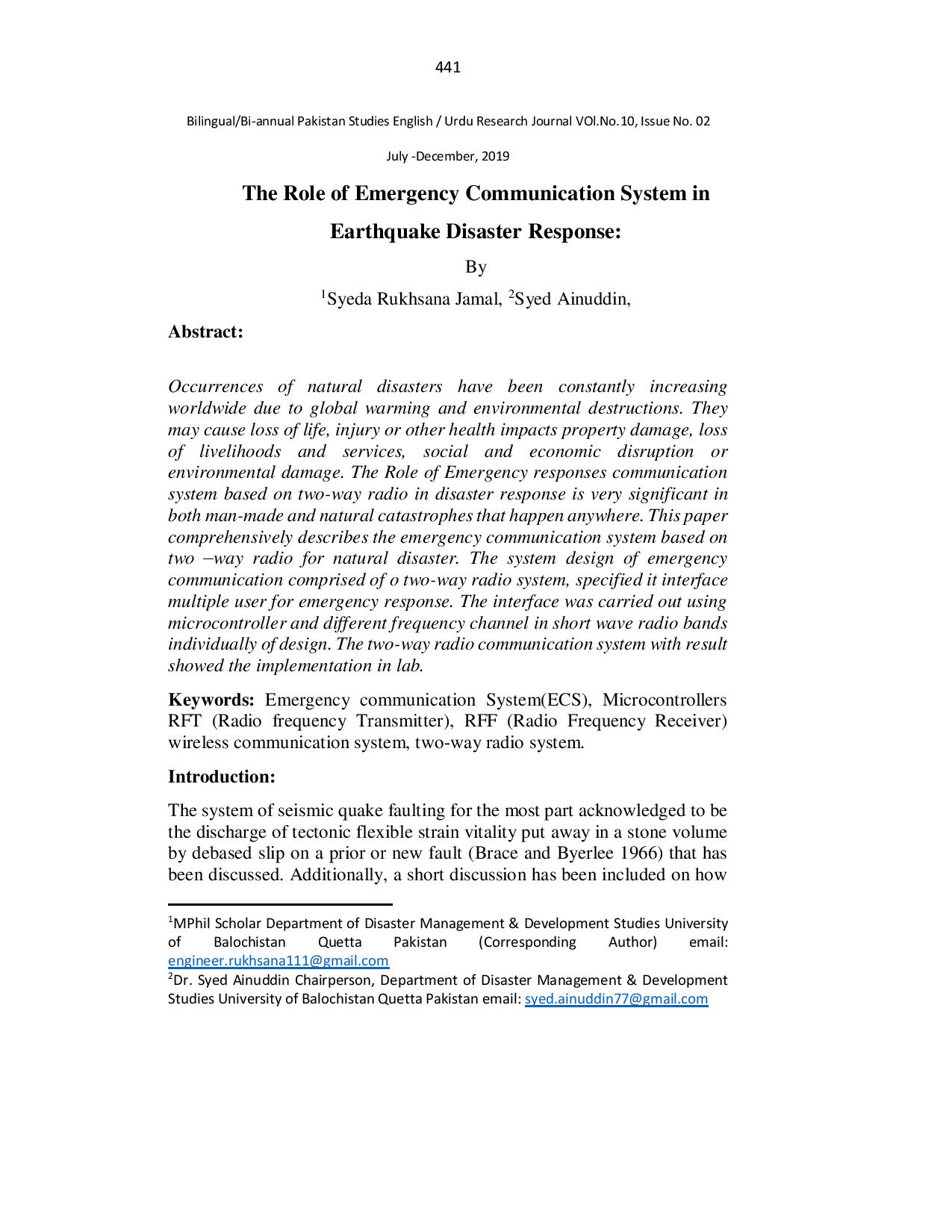The Role of Emergency Communication System in Earthquake Disaster Response
Keywords:
Emergency communication System(ECS), Microcontrollers RFT (Radio frequency Transmitter), RFF (Radio Frequency Receiver) wireless communication system, two-way radio system.Abstract
Occurrences of natural disasters have been constantly increasing
worldwide due to global warming and environmental destructions. They
may cause loss of life, injury or other health impacts property damage, loss
of livelihoods and services, social and economic disruption or
environmental damage. The Role of Emergency responses communication
system based on two-way radio in disaster response is very significant in
both man-made and natural catastrophes that happen anywhere. This paper
comprehensively describes the emergency communication system based on
two –way radio for natural disaster. The system design of emergency
communication comprised of o two-way radio system, specified it interface
multiple user for emergency response. The interface was carried out using
microcontroller and different frequency channel in short wave radio bands
individually of design. The two-way radio communication system with result
showed the implementation in lab.
References
Ann, S., & Kim, H. S. (2010). Relay association method for optimal path in
IEEE 802.16j mobile multihop relay networks. European
Transaction on Telecommunications,21(6), 624–631.
Bian, K., & Park, J. M. (2006). MAC-layer misbehaviours in multi-hop
cognitive radio networks. In International conference on science,
technology, and entrepreneurship (UKC), Korea, August 2006.
Ermolov V. et al. “Significance of Nanotechnology for future wireless
devices and Communications”, The 18th Annual IEEE International
Symposium on PIMRC’07. International Journal of NextGeneration Networks (IJNGN) Vol.4, No.3,September 2012 .
http://www.adpc.net/infores/adpc-documents/DisasComm.
http://www.adpc.net/v2007/ikm/resources/2007/july/adpcnewsv.13.pdf
http://saarc-sadkn.org/theme_tech_disaster.aspx
http://www.apnorc.org/PDFs/Resilience%20in%20Superstorm%20Sandy/
Commu nications_Final.pdf
Huang, J. H., Wang, L. C., Chang, C. J., & Su, W. S. (2010). Design of
optimum relay location in two-hop cellular systems.ACM/Springer
Wireless Networks,16(8), 2179–2189.
Ikki, S. S., & Ahmed, M. H. (2010). Performance analysis of best-path
selection scheme for multi-hop amplify-and-forward relaying.
European Transaction on Telecommunications,21(7), 603–610.
National Disaster Management Guidelines- National Disaster Management
Information and Communication System (NDMICS) 2011.
R.K.Jain, Risal Singh, “Role of Nanotechnology in future wireless and
communication systems”, National seminar proceeding, Academy
of Business & Engineering Science Ghaziabad, pp-19-28, 16-17th
January 2009.
Shin, J., Lee, D. K., & Cho, H. S. (2009). Is a multi-hop relay scheme
gainful in an IEEE 802.22-based cognitive radio system? IEICE
Transactions on Communications,92, 3528–3532.
The role of radio science in disaster Management P J Wilkinson and D. G.
Cole are with IPS, Bureau of Meteorology, Australia
Venkataraman, H., Sinanovic, S., & Haas, H. (2008). Cluster-based design
for two-hop cellular networks. International Journal for
Communications, Networks and Systems (IJCNS), 1(4), 370–385
Xie, R., Richard Yu, F., & Ji, H., (2011). Joint power allocation and beam
forming with users selec-tion for CR networks via discrete
stochastic optimization.ACM Wireless Networks.
doi:10.1007/s11276-0120413-8.
Zhuo Sun and Wenbo Wang “Investigation of Cooperation Technologies in
Heterogeneous Wireless Networks”, Journal of Computer Systems,
Networks, and Communications, Volume (2010), Article ID



